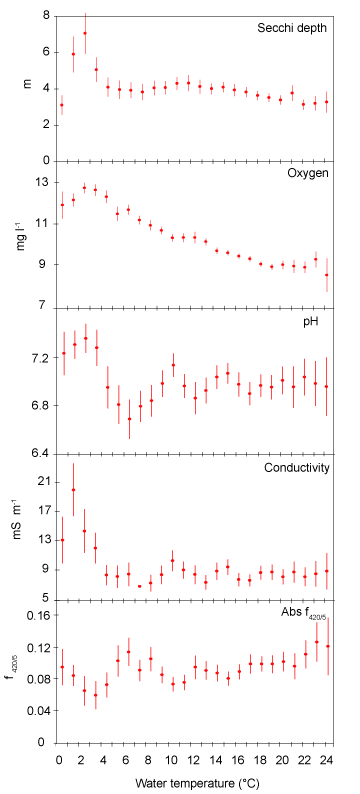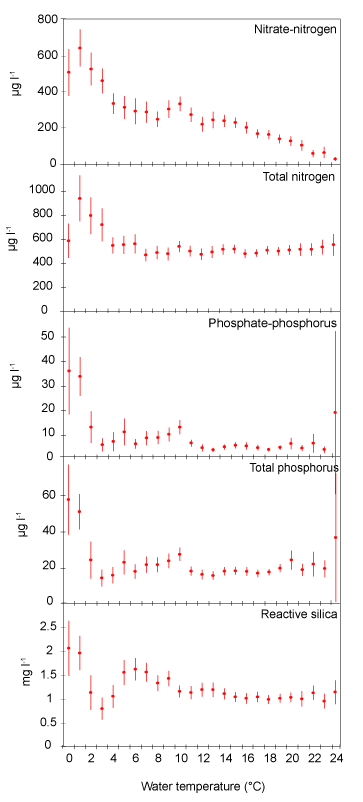 |
||
|
Temperature associated effects on chemical lake processes |
||
|
To get a first overview whether it is on a whole possible to establish a relationship between water temperature and a lake chemical variable, data from the national and regional monitoring programmes were taken (5110 sampling occasions). Since chemical lake processes are complex and consequently not only dependent on varying temperatures, clear relationships are rare (see figure). Of all chemical lake variables tested nitrate-nitrogen and oxygen showed the strongest association with water temperature (see figure). It needs to be stressed that the relationships do not reflect any causal relationships and care should be taken with the interpretations. It is not possible to differentiate whether water temperature itself or water temperature associated variables such as e.g. water discharge are the driving variable. The figures are meant to get a first overview. If a relationship of a chemical variable to water temperature has been detected further studies are necessary. Here, only suggestions of possible mechanisms for the observed relationships are given: nitrate-nitrogen concentrations started to decrease at water temperatures > 13 °C, and lowest nitrate-concentrations were found during summer in the southern part of Sweden. Here the phytoplankton biomass was highest (see Temperature effects on biological lake processes), indicating that nitrate-nitrogen might have been biologically uptaken (relationship between the total phytoplankton biomass and nitrate-nitrogen concentrations for water temperatures > 13°C: r2 = 0.88, n = 11, p < 0.001). Also oxygen concentrations showed, as expected, decreasing values with increasing water temperatures, mainly due to the lower gas solubility and to increased respiration rates1. The oxygen curve in relation to water temperature for the average of the Swedish lakes followed very nicely the standard curve of dissolved oxygen concentrations in pure water in equilibrium with water-saturated air at sea level in relation to water temperature2, resulting in that at 20 °C, the Swedish water holds, on average, oxygen concentrations of 9.04 mg l-1 corresponding to the expected 9.09 mg l-1. Most chemical variables showed highest values at water temperatures between 1 and 3°C. This is the time around ice-on and ice-off. Considering that global warming implies especially warmer winter temperatures with changes in the ice cover conditions in many lakes, it is likely that the time period of water temperatures around 2 °C and consequently high chemcial concentrations in the lake water might be prolonged compared to now. This gives new prerequisites for the development of e.g. phytoplankton in lakes. The only chemical variable that did not show highest values at low water temperatures was water color, measured as light absorption at 420 nm of 0.45 µ filtered water in a 5-cm cuvette. Here, on average, highest values were measured at water temperatures of 23 °C, i.e. during summer time in the southern part of Sweden. Considering that lakes in southern Sweden might function as indicators of future water quality features in areas further North due to changes in freezing conditions during winter, the problem of steadily increasing water color might continue if temperatures increase.
|
Relationship between water temperature and a variety of lake chemical variables (mean of 127 Swedish lakes and 5110 sampling occasions)
1 Kalff, J. 2002. Limnology. Prentice-Hall, Upper Saddle River, NJ, U.S. 591 pp. 2 Benson, B. B. and Krause, D. 1980. the concentration and isotopic fractionation of gases dissolved in freshwater in equilibrium with the atmosphere, 1. Oxygen. Limnol. Oceanogr. 25: 662-671. |
|

